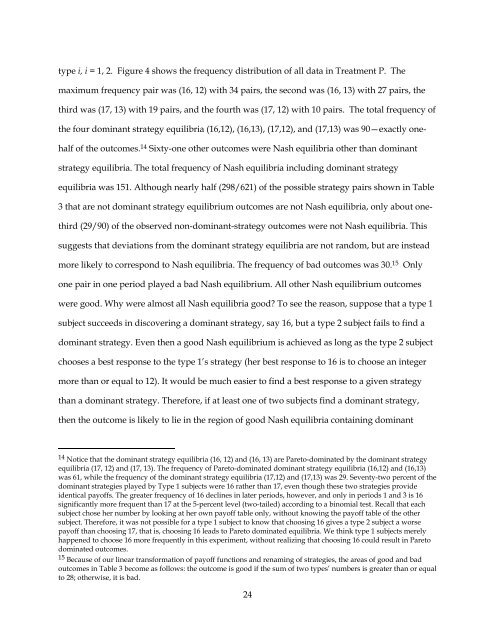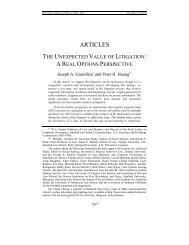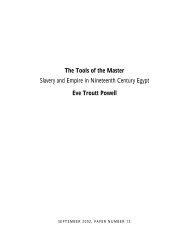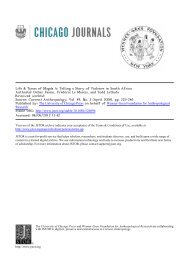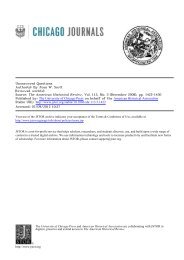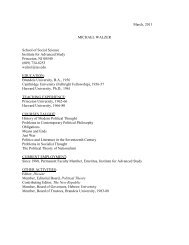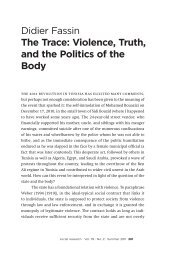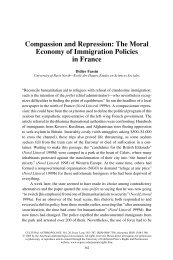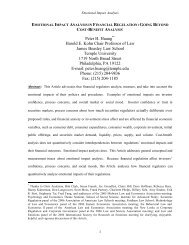Secure Implementation Experiments: Do Strategy-proof Mechanisms ...
Secure Implementation Experiments: Do Strategy-proof Mechanisms ...
Secure Implementation Experiments: Do Strategy-proof Mechanisms ...
Create successful ePaper yourself
Turn your PDF publications into a flip-book with our unique Google optimized e-Paper software.
type i, i = 1, 2. Figure 4 shows the frequency distribution of all data in Treatment P. The<br />
maximum frequency pair was (16, 12) with 34 pairs, the second was (16, 13) with 27 pairs, the<br />
third was (17, 13) with 19 pairs, and the fourth was (17, 12) with 10 pairs. The total frequency of<br />
the four dominant strategy equilibria (16,12), (16,13), (17,12), and (17,13) was 90—exactly onehalf<br />
of the outcomes. 14 Sixty-one other outcomes were Nash equilibria other than dominant<br />
strategy equilibria. The total frequency of Nash equilibria including dominant strategy<br />
equilibria was 151. Although nearly half (298/621) of the possible strategy pairs shown in Table<br />
3 that are not dominant strategy equilibrium outcomes are not Nash equilibria, only about onethird<br />
(29/90) of the observed non-dominant-strategy outcomes were not Nash equilibria. This<br />
suggests that deviations from the dominant strategy equilibria are not random, but are instead<br />
more likely to correspond to Nash equilibria. The frequency of bad outcomes was 30. 15 Only<br />
one pair in one period played a bad Nash equilibrium. All other Nash equilibrium outcomes<br />
were good. Why were almost all Nash equilibria good? To see the reason, suppose that a type 1<br />
subject succeeds in discovering a dominant strategy, say 16, but a type 2 subject fails to find a<br />
dominant strategy. Even then a good Nash equilibrium is achieved as long as the type 2 subject<br />
chooses a best response to the type 1’s strategy (her best response to 16 is to choose an integer<br />
more than or equal to 12). It would be much easier to find a best response to a given strategy<br />
than a dominant strategy. Therefore, if at least one of two subjects find a dominant strategy,<br />
then the outcome is likely to lie in the region of good Nash equilibria containing dominant<br />
14 Notice that the dominant strategy equilibria (16, 12) and (16, 13) are Pareto-dominated by the dominant strategy<br />
equilibria (17, 12) and (17, 13). The frequency of Pareto-dominated dominant strategy equilibria (16,12) and (16,13)<br />
was 61, while the frequency of the dominant strategy equilibria (17,12) and (17,13) was 29. Seventy-two percent of the<br />
dominant strategies played by Type 1 subjects were 16 rather than 17, even though these two strategies provide<br />
identical payoffs. The greater frequency of 16 declines in later periods, however, and only in periods 1 and 3 is 16<br />
significantly more frequent than 17 at the 5-percent level (two-tailed) according to a binomial test. Recall that each<br />
subject chose her number by looking at her own payoff table only, without knowing the payoff table of the other<br />
subject. Therefore, it was not possible for a type 1 subject to know that choosing 16 gives a type 2 subject a worse<br />
payoff than choosing 17, that is, choosing 16 leads to Pareto dominated equilibria. We think type 1 subjects merely<br />
happened to choose 16 more frequently in this experiment, without realizing that choosing 16 could result in Pareto<br />
dominated outcomes.<br />
15 Because of our linear transformation of payoff functions and renaming of strategies, the areas of good and bad<br />
outcomes in Table 3 become as follows: the outcome is good if the sum of two types’ numbers is greater than or equal<br />
to 28; otherwise, it is bad.<br />
24


